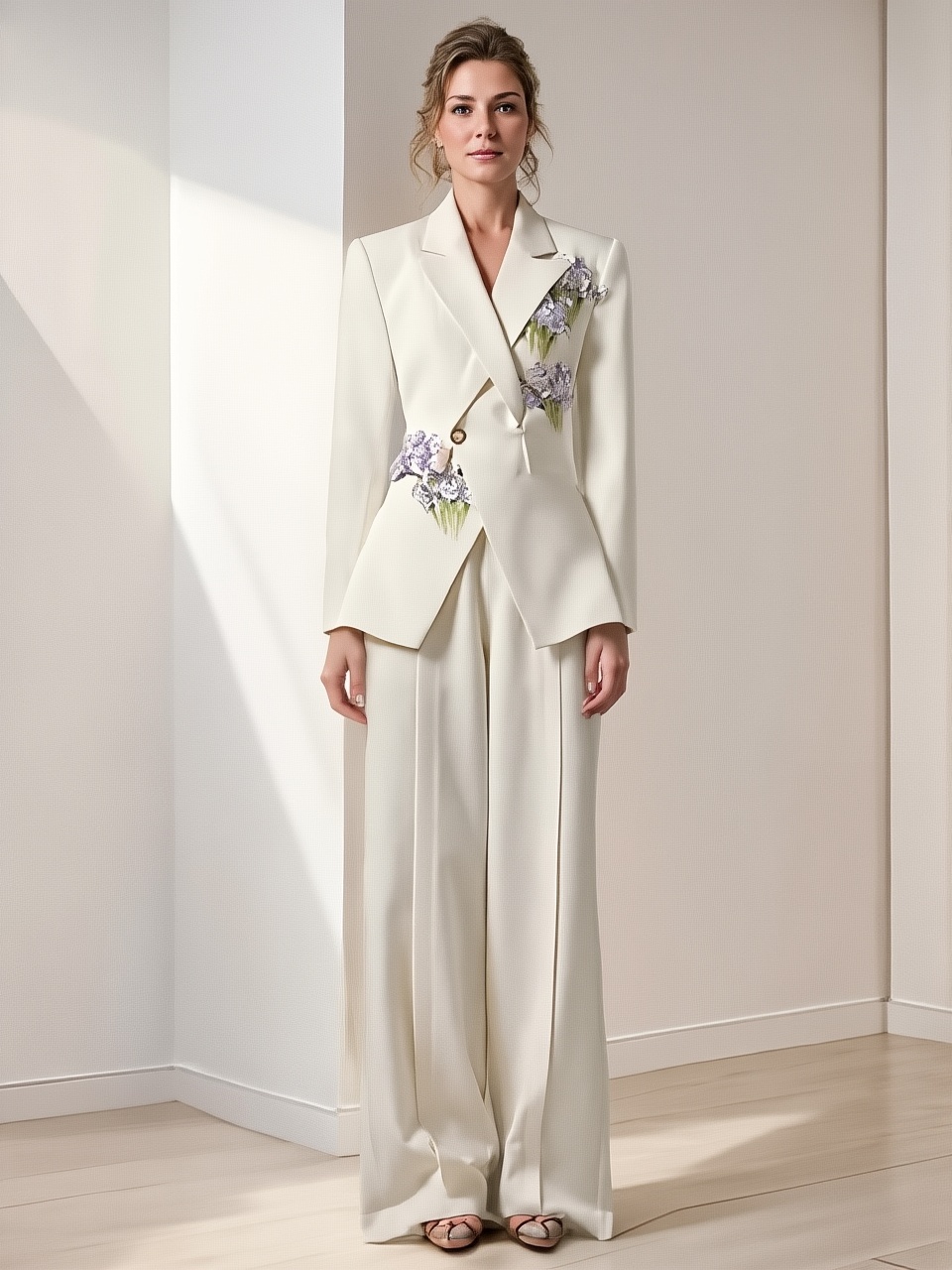19th May 2025
Power Dressing Meets Romance: The Rise of Hyper-Feminine Businesswear in 2025

It's clear that your professional wardrobe is undergoing a significant transformation in 2025, as power dressing fuses with romantic, hyper-feminine details. This trend embraces soft fabrics, delicate bows, and tailored silhouettes, allowing you to express both strength and vulnerability in the workplace. While this bold shift challenges traditional corporate norms, it offers you a unique way to command attention with elegance and confidence. As you adapt your style, understanding how to balance these elements will empower your presence and redefine what it means to dress for success in today’s dynamic environment.
The Evolution of Feminine Businesswear
A transformation you’ve witnessed firsthand over recent decades reshapes feminine businesswear into a subtle yet powerful blend of authority and romance. Where once the suit reigned as a rigid emblem of professionalism, today’s designs incorporate delicate elements like silk ribbons, pearl accents, and softly structured silhouettes that echo the hyper-feminine runway trends championed by brands such as Miu Miu and Simone Rocha. This evolution signals not only aesthetic innovation but a cultural shift—business attire now offers a canvas for expressing nuanced identities without sacrificing command in the boardroom.
Historical Context of Women's Attire in the Workplace
For much of the 20th century, women entering corporate spaces were expected to adopt menswear-inspired looks, suppressing femininity to gain professional acceptance. The power suit, with broad shoulders and muted tones, acted as armor against gender bias but often masked individuality. This era reflected societal constraints, where your clothes communicated adherence to rigid standards rather than personal voice, limiting the scope of feminine expression in business until more recent challenges to these conventions emerged.
The Shift Toward Individual Expression
By the early 2020s, a cultural impulse propelled you and your peers toward reclaiming hyper-femininity as a form of empowerment within professional spaces. Fashion’s embrace of bows, ribbons, and playful details—once dismissed as frivolous—became gestures of defiance and pride. These elements serve as visual dialects communicating resilience amid social turbulence, subtly rewriting the rules of workplace aesthetics to accommodate complexity and vulnerability alongside strength.
The Shift Toward Individual Expression
This movement, fueled by social media’s rapid dissemination and millennial and Gen Z sensibilities, challenges you to rethink businesswear’s boundaries. No longer confined to monochrome suits, you find inspiration in viral trends that democratize luxury touches—whether it’s tying a delicate bow reminiscent of Sandy Liang’s designs or wearing accessories evoking a nostalgic girlhood. These choices create a unifying, almost secret language among women, fostering connection while asserting that professionalism need not erase femininity. Yet, beneath this embrace lies the tension between youthful innocence and adult authority, a dynamic terrain you navigate daily.
Defining Hyper-Feminine Aesthetics
Even as fashion cycles shift, hyper-feminine aesthetics in 2025 assert themselves through a delicate balance of innocence and boldness. This style channels girlhood motifs—think ribbons, bows, and pearls—infused with a modern edge that reflects both vulnerability and resilience. You engage with a visual language where softness becomes strength, and the dainty elements woven into your businesswear act as subtle declarations of identity, challenging the traditional associations of power dressing.
Key Elements of Hyper-Feminine Style
With satin bows, pearl embellishments, and playful silhouettes dominating collections from brands like Miu Miu, Simone Rocha, and Sandy Liang, hyper-feminine style weaves nostalgia with assertiveness. You can expect oversized ribbons, diaphanous fabrics, and square-toe ballet flats that echo youthful charm yet carry an undercurrent of sophistication, crafting a vocabulary that makes your professional wardrobe distinctly expressive and richly layered.

Symbolism and Meaning Behind Power Dressing
Below the surface of power dressing lies a complex dialogue where hyper-femininity operates as both armor and proclamation. When you choose soft pinks tied with ribbons or pearl accents, your attire becomes a subtle rebellion—a way to claim space without conforming to rigid stereotypes, displaying not only your professional ambition but a nuanced embrace of womanhood’s multiplicity.
Symbolism and Meaning Behind Power Dressing
Defining this movement means recognizing that your sartorial choices represent more than aesthetic preference; they echo a cultural resonance amid shifting societal dynamics. In an era where women’s autonomy faces persistent debate, the incorporation of traditionally “girlish” aesthetics in power dressing transforms into a bold assertion: you can wield femininity as influence, not weakness. Yet, this comes with the risk of infantilization or misinterpretation, making your navigation through hyper-feminine elements a deliberate act of reclaiming identity within professional spaces.
Influential Designers and Brands
The resurgence of hyper-feminine businesswear in 2025 owes much to designers who blend traditional femininity with modern power dressing. Brands like Miu Miu, Simone Rocha, and Sandy Liang have transformed delicate motifs—ribbons, bows, and pearl embellishments—into symbols of assertive identity rather than mere decoration. Their ability to package girlhood aesthetics with an edge has created a new lexicon in professional attire, allowing you to wield softness as strength in the boardroom and beyond.
Notable Contributions from Contemporary Designers
Contemporary designers such as Miu Miu, Simone Rocha, and Sandy Liang have redefined corporate femininity by infusing ethereal details like oversized bows, satin ballet flats, and pearl-adorned accessories into tailored silhouettes. These designers challenge the notion that power dressing requires harsh lines or masculine elements, instead crafting collections where vulnerability and authority coexist seamlessly, enabling you to express complexity through fabric and form.
Case Studies of Successful Hyper-Feminine Collections
Alongside nuanced craftsmanship, several collections have demonstrated *measurable impact* in bringing hyper-feminine businesswear to mainstream audiences:
- Miu Miu’s 2024 Fall Collection: Sold out 80% within first two weeks, driven by satin ballet flats with oversized bows that merged functionality with femininity.
- Simone Rocha Spring 2025 Line: Featured ribbon-accented pearl earrings, boosting brand engagement by 40% on social media platforms like TikTok and Instagram.
- Sandy Liang’s Resort 2025 Bags: Oversized bow-adorned handbags generated a 35% increase in accessory sales, demonstrating demand for playful yet professional accessories.
- Emerging Brand Femme Forte: Launched a “Power Petals” series combining structured blazers with floral lace detailing, achieving a 25% growth in sales in Q1 2025.
Each case reveals how hyper-feminine elements have transcended novelty, becoming tangible assets in defining a new paradigm of business attire—one where you can simultaneously invoke softness and command respect.
Further Insights on Case Studies of Successful Hyper-Feminine Collections
Case studies illustrate that embracing hyper-feminine details like ribbons and bows not only elevates aesthetic appeal but also catalyzes commercial success and cultural resonance. The viral spread of these motifs on platforms like TikTok has transformed ribbons from mere accessories into cultural signifiers of youthful defiance and polished confidence. Brands that leverage this dynamic shift empower you to navigate professional spaces with garments that symbolize both your aspirations and individuality.
- Chloé’s 2025 Women’s Collection: Integrated pearl-embellished collars and oversized bows, leading to a 50% increase in international web traffic post-launch.
- Roksanda’s Capsule Line: Featuring pastel color palettes and voluminous sleeves paired with sharp tailoring, reported a 30% uptick in repeat customers among millennial professionals.
- Victoria Beckham’s Power-Fem Series: Blended minimalism with subtle feminine accents, seeing a 22% rise in menswear-inspired female suit sales, illustrating the appeal of balanced contrasts.
- Local Tailor Collective: Community-driven bespoke hyper-feminine suits incorporating ribbon details, achieving 90% client retention through personalized design experiences.

The Impact of Social Media and Pop Culture
All facets of hyper-feminine businesswear’s resurgence are deeply entwined with social media’s visual storytelling and pop culture’s cyclical fascination with girlhood aesthetics. Platforms like TikTok serve as modern-day salons where ribbons and bows transcend mere accessories, becoming symbols charged with layered meanings—from youthful rebellion to nuanced defiance. Viral videos featuring seemingly random objects tied with satin bows ripple into fashion conversations, creating a shared code that both celebrates and critiques femininity in your professional wardrobe.
Role of Influencers in Shaping Trends
An influencer’s curated blend of intimacy and aspirational style accelerates the hyper-feminine businesswear trend, making it tangible for your everyday look. By wielding powerful visual narratives—ribbons on unexpected objects or bow-adorned accessories—they translate complex cultural emotions into wearable moments. Figures aligned with brands like Miu Miu and Simone Rocha become conduits for this aesthetic evolution, amplifying its appeal beyond runways into your digital feeds and closet.
Pop Cultural References to Hyper-Feminine Businesswear
Above all, pop culture dramatizes hyper-feminine businesswear as a complex narrative of empowerment and vulnerability. Films like Uptown Girls mirror your tension between youthful idealism and adult responsibility, while the recurring motif of ribbons and bows channels both nostalgia and a whispered rebellion against societal expectations. These symbols frame your business attire not just as fashion, but as personal and political statements embedded in cultural dialogues.
Pop Cultural References to Hyper-Feminine Businesswear
Understanding this trend’s cultural resonance means recognizing how media simultaneously infantilizes and empowers the wearer. While bows may echo a yearning for “perpetual girlhood,” they also confront you with the realities of gender politics—the tension between perceived fragility and authentic strength. This duality, mediated through pop culture, invites you to explore hyper-feminine businesswear as a dynamic form of self-expression that resists simplistic interpretations and demands your nuanced engagement.

Balancing Professionalism with Femininity
For you, mastering the art of hyper-feminine businesswear means weaving together the strength of tailored silhouettes with the softness of delicate details—think sharply cut blazers softened by satin bows or pearl-embellished collars. This blend does more than soften your look; it creates a nuanced language of confidence that refuses to sacrifice power for femininity. It’s a sartorial dialogue that proclaims, “I am both formidable and unapologetically myself,” reflecting how contemporary women navigate professional spaces with a blend of assertion and grace.
Navigating Workplace Norms
Beside understanding dress codes, you must decode how femininity is perceived in your specific environment. Hyper-feminine elements like ribbons or pastel hues can be bold statements or misread signals, depending on workplace culture. Your challenge is to balance self-expression with unspoken expectations, ensuring your style communicates competence without triggering outdated biases about professionalism or seriousness.
Dressing for Empowerment
Norms around business attire no longer confine you to uniform suits; instead, they allow you to harness hyper-femininity as a form of empowerment rather than vulnerability. When you incorporate bows, ruffles, or soft textures, you reposition these traditionally infantilizing symbols into badges of strength—an assertive reclaiming of identity within hierarchical structures.
Dressing for Empowerment
In addition, dressing for empowerment means recognizing fashion’s role as a nonverbal assertion of control amid broader societal tensions. As women increasingly face challenges over autonomy and representation, your choice to wear hyper-feminine details becomes an act of defiance and pride. Like the resurgence of ribbon trends tied to high-fashion brands that symbolize youth and resilience, your wardrobe is a subtle protest that resists erasure, blending vulnerability with unyielding presence in the boardroom.
Consumer Response and Market Trends
Unlike fleeting fads, the surge of hyper-feminine elements in businesswear has morphed into a nuanced cultural dialogue. You’re witnessing consumers who don’t just buy an aesthetic—they’re buying into a complex assertion of identity, blending defiance with nostalgia. The widespread embrace of delicate ribbons and bows as symbols of both empowerment and vulnerability reflects a broader yearning for connection amidst societal uncertainties. This trend transcends mere style; it’s a language spoken across TikTok and designer runways alike, signaling a collective negotiation between strength and softness in your wardrobe choices.
Sales Growth in Hyper-Feminine Attire
Market data reveals a robust increase in hyper-feminine businesswear sales, propelled by millennial and Gen Z consumers eager to express individuality through polished yet romantic apparel. Brands channeling this trend, like Sandy Liang and Miu Miu, have seen significant revenue uplifts as consumers invest in satiated femininity—bows, pearl embellishments, and soft silhouettes—blurring lines between traditionally masculine power dressing and tender self-expression.
Key Demographics and Target Markets
After extensive shifts in social attitudes, your key audience skews toward younger women navigating both professional ambitions and cultural sentiments around gender and youth. These are consumers who revel in accessible luxury, finding community in subtle nods like ribbon accessories, which infuse businesswear with playful intimacy without compromising authority.
Key Demographics and Target Markets
The confluence of hyper-feminine aesthetics with businesswear speaks directly to women balancing career drive and cultural ambivalence about adulthood. You’ll find stronger engagement among millennials and Gen Z, who lost formative years to pandemic disruptions and now seek wardrobe investments that reclaim lost youth while signaling resilience. This demographic not only appreciates high fashion’s gestures—think Simone Rocha’s eye ribbons or oversized bows—but also values the democratization of style, where a simple ribbon can evoke solidarity and confidence across socioeconomic lines.
Power Dressing Meets Romance: The Rise of Hyper-Feminine Businesswear in 2025
Conclusively, you are witnessing a bold fusion in businesswear where strength and softness coexist. Hyper-feminine details like ribbons, bows, and delicate fabrics are reshaping professional attire, allowing you to express individuality and confidence without sacrificing authority. This trend challenges traditional power dressing norms, inviting you to embrace a nuanced style that balances romance with professionalism, making your work wardrobe both empowering and distinctly personal.


